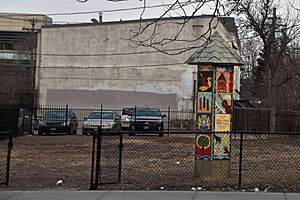Dania Hall (Minneapolis) facts for kids
Quick facts for kids Dania Hall |
|
|---|---|
 |
|
| General information | |
| Type | community center |
| Architectural style | Victorian eclectic |
| Location | 427 Cedar Avenue South Minneapolis, Minnesota |
| Coordinates | 44°58′08″N 93°14′49″W / 44.96902°N 93.24689°W |
| Completed | 1886 |
| Demolished | 2000 |
| Owner | Society Dania |
| Design and construction | |
| Architect | Carl F. Struck |
Dania Hall was a special building in Minneapolis, Minnesota. It was a place where people gathered for fun, shows, and community events. Built in 1886, it sadly burned down in 2000 during a big project to fix it up.
Contents
What Was Dania Hall?
Dania Hall was a tall, five-story building located at 427 Cedar Avenue South in the Cedar-Riverside neighborhood. It was designed by an architect named Carl F. Struck, who was from Norway. A group called Society Dania, started by Danish immigrants, built it.
The building had a huge auditorium on its third and fourth floors. This big room had a stage and a balcony shaped like a horseshoe. The main floor could hold up to 600 chairs for events or be cleared for dancing. The second floor had offices and a small meeting room. The ground floor and basement were used for shops.
Dania Hall was a busy place for many different groups. It was a gathering spot for people from Denmark, Sweden, and Norway, as well as the wider community. They held many events there, like:
- Banquets (big dinners)
- Bazaars (sales events)
- Concerts
- Dances
- Plays
- Evenings of Scandinavian vaudeville (a type of variety show with music and comedy)
Famous Visitors and Performers
A famous Norwegian author named Knut Hamsun lived in Minneapolis in the 1880s. He gave several talks at the new Dania Hall. His last speech there in 1888 included ideas that later appeared in his book The Cultural Life of Modern America.
In the 1920s and 1930s, many Scandinavian-American artists performed at Dania Hall. Some of these popular performers included:
- The Olson Sisters
- Olle i Skratthult
- Ted Johnson and his Midnight Suns
- Thorstein Skarning and his Norwegian Hillbillies
Later, from 1972 to 1977, a festival called the Snoose Boulevard Festival took place. It brought back the music and humor from that earlier time. Performances were held at places like the Cedar Theater and Mixed Blood Theatre. Dania Hall was a symbol of the area's Scandinavian past. It even flew a banner from Sweden during the festival, but the building itself was too old and run-down to be used for performances.
Later Years of Dania Hall
By the 1960s, the Cedar-Riverside neighborhood had changed a lot. It was no longer the main center for Scandinavian-American activities. In 1963, Society Dania sold the building to Phil Richter. His pharmacy had been on the first floor since 1948.
Even though the Scandinavian-American community used Dania Hall less, many young people started going there in the 1960s and 1970s. They came to hear rock bands like T.C. Atlantic and the Paisleys, and reggae music from Shangoya. In its very last years, the main auditorium was no longer used. It couldn't get a permit for public gatherings because it needed more exits and other safety improvements.
Fire and Aftermath
In 1991, a fire badly damaged Dania Hall's roof and upper floors. The roof was fixed, and by the end of the 1990s, a big project to fully restore the building had started.
However, in the early morning of February 28, 2000, another fire broke out. This fire completely destroyed the building, leaving only a burned ruin. Investigators said the fire was accidental, likely caused by a discarded cigarette. Still, some people had questions about the fire and why the building didn't have insurance.
A memorial gathering was held on March 2, 2000, at the Cedar Cultural Center. Hundreds of people came to remember Dania Hall and share their thoughts about the old landmark. They also listened to recordings of two Swedish songs: Hälsa dem därhemma (Greet those at home) and Barndomshemmet (My childhood home). The singer, Olga Lindgren-Nilsen, had recorded these songs in 1975 when she was 79 years old. She was the first wife of Olle i Skratthult and had performed many times on the Dania Hall stage.
In October 2001, a special pillar was put up where Dania Hall used to stand. This important spot for the Scandinavian-American community and the Cedar-Riverside neighborhood has been an empty lot since then.
Interestingly, Dania Hall's architect, Carl F. Struck, still has another building in the area. A two-story building he designed in 1890 is still in use at 521 Cedar Avenue South.
Historic Recognition
Dania Hall was added to the National Register of Historic Places in 1974. This list recognizes important historical buildings. After it was destroyed in 2000, it was removed from the list.
Two other buildings designed by Carl F. Struck are still on the National Register of Historic Places:
- The Bardwell–Ferrant House at 2500 Portland Avenue South
- The Pracna Building in the St. Anthony Falls Historic District
The main building of the Grain Belt Brewery in Northeast Minneapolis is also on the National Register of Historic Places. While Carl F. Struck didn't design the main brewery building, he was the architect for an office building at 1215 Marshall Street NE that was part of the brewery complex.


